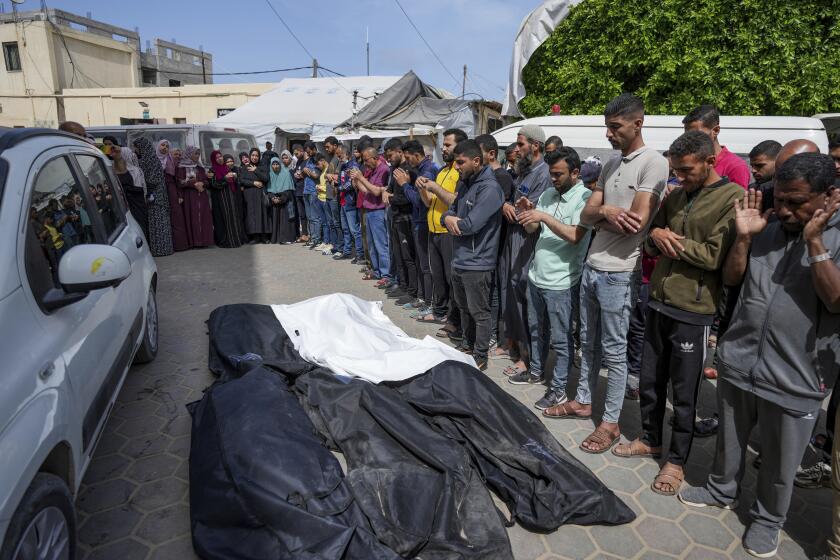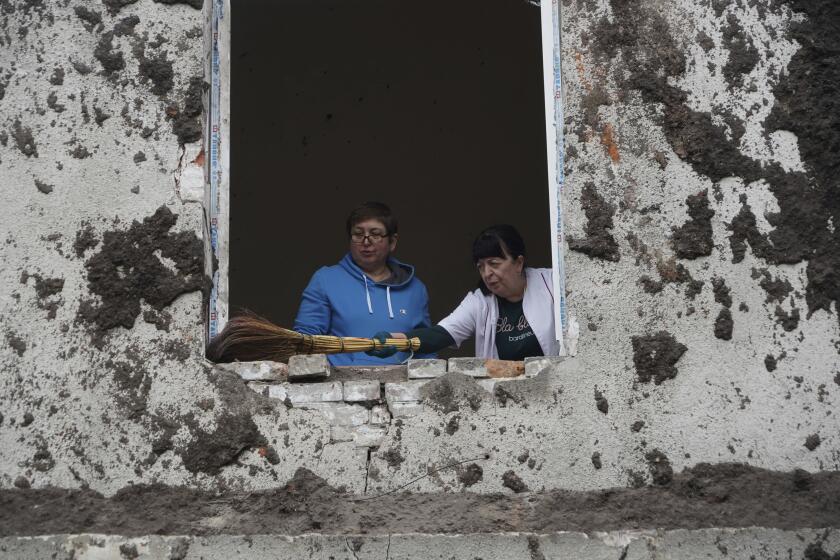SAVE YOURSELF
After years of warnings, community leaders this summer prepared a video guide to hurricane evacuations with a stark message: Many of this city’s poor, including 134,000 without cars, could be left behind in a killer storm.
But the 30-minute DVD still has not arrived. Some 70,000 of the newly minted videos that were to be released this month remain on warehouse shelves in Los Angeles.
For the record:
12:00 a.m. Sept. 15, 2005 For The Record
Los Angeles Times Thursday September 15, 2005 Home Edition Main News Part A Page 2 National Desk 1 inches; 42 words Type of Material: Correction
Safety plan for poor -- An article in Tuesday’s Section A about New Orleans’ hurricane preparations for the poor referred to a French Quarter statue as being of Gen. Stonewall Jackson. The statue at the center of Jackson Square depicts Andrew Jackson.
Their warning: Save yourself, and help your neighbors if you can.
“Don’t wait for the city, don’t wait for the state, don’t wait for the Red Cross,” the Rev. Marshall Truehill warns in the public service announcement.
The program, titled “Preparing for the Big One,” was one of several related but incomplete plans aimed in particular at the one-quarter of the city’s population that did not own cars or have ready transportation out of town in the event of evacuation orders.
Churches had agreed to provide rides to those without cars as part of “Operation Brother’s Keeper,” but a pilot program had been started in only four large congregations.
The Regional Transit Authority, the city’s bus system, had a plan to transport people from a dozen pre-designated evacuation points, but some residents reported waiting interminably for buses that didn’t show up as the storm bore down Aug. 28.
From the Federal Emergency Management Agency to the state government and City Hall, officials knew that the poorest residents in the city would be in danger if New Orleans took a direct or near-hit from a major hurricane. Not only did so many lack the means to flee in an evacuation, but they also tended to live in geographically vulnerable, low-lying parts of town.
“It almost makes me want to cry,” Truehill, 57, said of the unfinished evacuation plans during an interview in his temporary Baton Rouge, La., office Monday. “We knew we were going to lose thousands of lives.”
Ann Duplessis, the Democratic state senator who represents the Lower 9th Ward, where many of the city’s poor lived, said officials had been working on a solution.
“Within nine months a lot happened,” Duplessis said. “A strategy was developed. The tapes were done. Commercials were prepared.... [The hurricane] just came too fast.”
National Guard Lt. Col. William J. Doran III, who heads Louisiana’s emergency response system, said that the state’s disaster plan had been 90% complete when Katrina struck. Only the transportation element “hadn’t been fleshed out,” Doran said.
Those trying to clear the city in advance of the deadly storm faced obstacles besides the dearth of vehicles in the poor sections of the city.
Most significant, residents of the Crescent City had been numbed by years of warnings about hurricanes that either petered out or turned before they reached New Orleans.
“People don’t understand this who don’t live down here, but when a voluntary evacuation comes, people choose not to go. They have been through hundreds of these,” said a state health official who asked not to be named because she was not authorized to speak to the news media. “Then when it’s a mandatory evacuation, sometimes it’s too late.”
The hurricane threat confronting New Orleans’ poor had been an open secret for years. In September 2002, FEMA called a meeting with city and church leaders to discuss how to assure that no one was left behind, Truehill recalled.
But even as officials tried to work with community groups and churches to find a solution, problems arose. Among them was a concern that residents and parishioners who gave their neighbors lifts out of the city could face legal liability if something went wrong.
Democratic state Sen. Francis C. Heitmeier last year introduced legislation to release drivers in a hurricane emergency from liability, and the measure passed easily in the Senate. But it encountered unexpected opposition in the Louisiana House of Representatives. Some members wondered, for instance, whether a drunken driver could escape responsibility for an accident if he or she was transporting an evacuee.
Heitmeier recalled arguing, “Why would y’all want to vote against poor people getting out from a storm?” But to no avail. The bill died.
The lack of liability protection slowed progress, and only the four churches were involved in the pilot program.
That left the DVD as a stopgap. The city contracted to have the program produced by Total Community Action. Truehill, pastor of the city’s First Baptist Church, heads the community group’s faith-based network.
Had the DVDs been ready in time, they would have been delivered through churches in the city. Truehill said he believed that, even in poor parts of town, residents had the equipment to play the discs.
The messages from Duplessis, Mayor C. Ray Nagin and other officials were also supposed to be broadcast on television as public service announcements.
But it was only at 11:30 a.m. Sunday, Aug. 28, about 18 hours before Katrina made landfall, that most residents would even have heard anything about “Preparing for the Big One.”
That’s when Truehill appeared on the local ABC-TV affiliate in a taped segment to tell viewers that the helpful DVD was coming soon.
A copy of the DVD, reviewed by The Times, shows Truehill in a series of on-camera chats with co-host Allan Katz, a local public relations executive, and other civic and state leaders. The minister says, “It’s your personal responsibility” to escape before a hurricane.
Also on the DVD, Nagin says that public schools are no longer considered safe as city shelters.
“Everybody needs to have their own plans,” Nagin says. “Check with your neighbors, check with your relatives.”
The program also features advice on how to clear storm drains, pack an evacuation kit and ensure adequate medical supplies. A representative from the Louisiana Society for the Prevention of Cruelty to Animals gives advice on how to keep a pet safe.
Duplessis displays her own evacuation toolbox, a plastic case stuffed with necessities such as flashlights, jumper cables and a battery-powered television.
But for people without transportation, the DVD offers little beyond advising them to find a ride with someone.
Other plans to aid evacuation remained unfinished as well.
Truehill’s organization had secured promises from Amtrak to ferry carless residents to safety, for example. There were reports that at least one Amtrak train got out of the city with evacuees.
Some 275 public buses had been lined up to carry the most vulnerable from the city, but drivers were in short supply. Recruitment of bus drivers was barely underway when the storm shut it down.
A plan to warehouse life vests and rubber rafts also remained on the drawing board. Truehill said he had intended to submit an acquisition plan to the city. But even then, city leaders had been counting on federal funding to put much of the plan into place.
At least one goal had been met: the distribution of 700,000 pamphlets specifying what items to bring during an evacuation. Red Cross officials say the pamphlets’ advice apparently was heeded by many who fled the storm.
Even if the entire plan had been operational, it contemplated 72 hours’ notice to get everyone out. Only half that time was left when mandatory evacuation orders were issued by Nagin and Gov. Kathleen Babineaux Blanco.
Truehill himself had no time to try salvaging elements of his plan. Like most residents, he had learned that Katrina had turned toward the city the morning of Saturday, Aug. 27. He spent the day scrambling to board up his home and his church, then rushed his family out of town hours before his pre-recorded image appeared on New Orleans television.
The last reasonable chance to escape Katrina passed Sunday afternoon. The storm made landfall on the coast at 6:10 the next morning.
The potential danger had become clear at least three years earlier at FEMA’s meeting with local religious and political leaders. It was held in the conference room of the Archdiocese of New Orleans.
Truehill recalled that FEMA officials showed the gathering a computer simulation, called a slosh model, predicting floodwaters rising to the horse’s hoofs of Gen. Stonewall Jackson’s statue in the French Quarter.
Detailed surveys and census data had revealed a relatively low percentage of car ownership in much of the city. In the Lower 9th Ward, 36% live below the poverty level; nearly one-third of residents had no car.
Concluded Rev. Truehill: “We knew neither the city nor anyone else had the means to move those people.”
Times staff writer Josh Meyer in Baton Rouge contributed to this report.
More to Read
Start your day right
Sign up for Essential California for news, features and recommendations from the L.A. Times and beyond in your inbox six days a week.
You may occasionally receive promotional content from the Los Angeles Times.







